Amazon Editorial Reviews: Are You Using This Incredible Section?

Today’s guest post is by Dave Chesson (@DaveChesson) of Kindlepreneur.
Amazon editorial reviews are one of the most underrated tools in a self-publishing author’s arsenal—that’s because most authors either don’t know what they are or how to access them. Editorial reviews are book evaluations that are usually written by an editor or expert in the book’s genre or field. You can find them on your book’s sales page, just above the About the Author section.
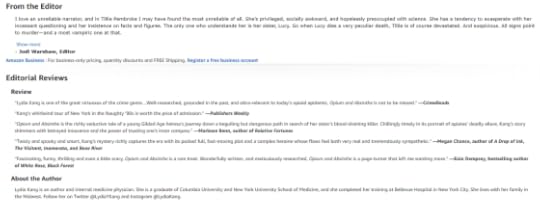 Why are these editorial reviews so important? They’re a legit form of social proof on your book’s sales page.Editorial reviews are NOT Amazon reviews and thus do not follow Amazon review rules.You can reach out to just about anyone to get an editorial review.As you’ll see a little later on in this article, a lot of readers check out the editorial reviews before they decide to buy—along with your blurb, cover and look inside, editorial reviews are one of the factors that help readers decide whether your book is worth their time or not.
Why are these editorial reviews so important? They’re a legit form of social proof on your book’s sales page.Editorial reviews are NOT Amazon reviews and thus do not follow Amazon review rules.You can reach out to just about anyone to get an editorial review.As you’ll see a little later on in this article, a lot of readers check out the editorial reviews before they decide to buy—along with your blurb, cover and look inside, editorial reviews are one of the factors that help readers decide whether your book is worth their time or not.With all that said, it’s pretty surprising that more authors aren’t taking advantage of this editorial review section. Let’s take a look at how you can access the editorial review section and upload your reviews.
How to Create an Editorial ReviewTo access your editorial review section and enter your editorial reviews, simply follow these steps:
Head over to Author Central and login to your account.Navigate to the Books tab. Select the book for which you want to edit the review section.Here, you’ll find you can edit several areas: Review, Product Description, From the Author, From the Inside Flap, From the Back Cover, and About the Author.
Select the book for which you want to edit the review section.Here, you’ll find you can edit several areas: Review, Product Description, From the Author, From the Inside Flap, From the Back Cover, and About the Author.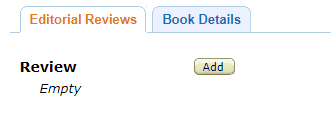 Hit the Add button.You’ll be given a text box to add reviews and general guidelines for adding them according to Amazon’s specifications. You can add them in the text editor or use the HTML tab to make your reviews look smart using HTML codes.
Hit the Add button.You’ll be given a text box to add reviews and general guidelines for adding them according to Amazon’s specifications. You can add them in the text editor or use the HTML tab to make your reviews look smart using HTML codes.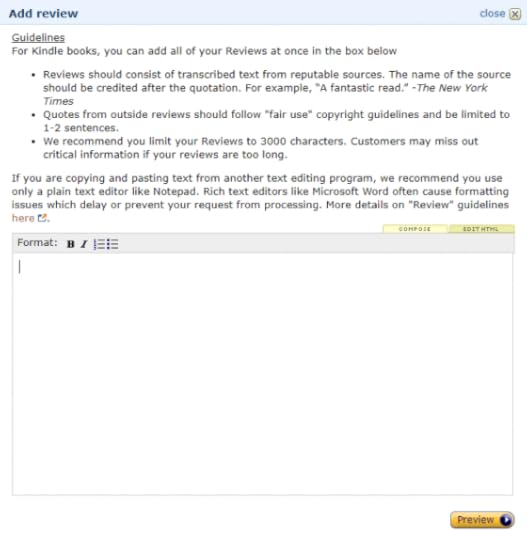 Once you’ve added your review, simply hit Preview, then Save Changes and you’re all set!
Once you’ve added your review, simply hit Preview, then Save Changes and you’re all set!
Now that you know how to upload your editorial book reviews, you might be wondering where to get reputable reviews. It’s no use entering editorial reviews that don’t make sense or don’t offer good social proof for the reader.
Where to Get Editorial ReviewsYou might be a little worried about where to source your editorial reviews. Well, I’ve got some good news for you. Pretty much anything and everything is allowed in the editorial reviews section.
That’s because editorial reviews and customer reviews are two completely separate things. Customer reviews are written by people who have bought your book and is thus a fiercely guarded component of Amazon. Whereas editorial reviews are written by people who’ve received your book and agreed to do a review for you. A really nice one because you can choose what you put there.
The only things Amazon lists to avoid in Editorial Reviews are:
Phone numbers, addresses, or URLsTime-sensitive statements or statements specific to one edition or listingAdvertisements or promotional materialAvailability, price, or alternative ordering/shipping informationProfanity or spiteful remarksObscene or distasteful contentThat’s it!
They’re basically testimonials, and you’re allowed to ask just about anyone to give one for your book—from professional reviewers to your own family members.
Obviously, you’ll want the best possible editorial reviews. I’d advise that you get reputable bloggers or websites to offer you a review, and to ensure that they’re in-line with your genre.
Here are a few tips for finding editorial reviewers:
Look for recognizable domain names in your genre like TopSciFiBooks.com if you’ve written a sci-fi book, for instance—and reach out for a review.Find other authors in your genre or niche and ask them to read your book and give a testimonial.Approach reputable online magazines.Pay a professional reviewer to read your book and give you a testimonial—you could even use Fiverr for this.Remember to grab a 1–2 sentence snippet from each of these sources and to credit them when uploading them to your review section.
Once you have your reviews, you might be tempted to put them up right away–but the design of your review actually matters. So, let’s take a look at how your review should be structured so you can better take advantage of them.
How to Design Editorial Reviews on Your PageBelow, you’ll find a heat map image that was taken from shoppers on Amazon using a camera that tracked exactly where their eyes would go on the page and where they clicked. The results are pretty amazing and give some great insight into how shoppers make their buying decisions and which information is most important to them.
Check it out:
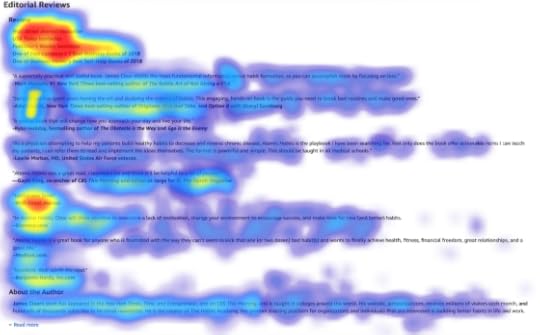
We noticed the following important fact about these shoppers:
Most people don’t actually read the quote. Instead they focus more on who said it, or their qualifications.
What does that mean for authors?
Well, that they should probably be italicizing their quote and bolding the qualifier. What I mean about a “qualifier” is what would the shopper know. If the person is famous, then bold their name. However, if they aren’t then bold that which makes them pertinent or “qualified” to speak on your book.
For example, if the person who’s given you your editorial review is an author in your genre but isn’t super famous, then the qualifier that you would bold would be “Bestselling author in [genre].” That statement would mean more than the author’s name. If you used a review blog, however, the qualifier is the domain name, not the individual reviewer, especially if that domain name applies to your genre. Like TopSciFiBooks.com applies to sci-fi or Tor.com applies to fantasy.

So, if you want to stand out, you need to design your reviews for success. But how do you do that? By using the HTML tab in your review section and using a handy tool I designed for just this purpose.
The Kindlepreneur Book Description Generator allows you to design your editorial reviews and download the HTML code you’ll need to input directly into your HTML tab of the review section for your book in Author Central.
Check it out.
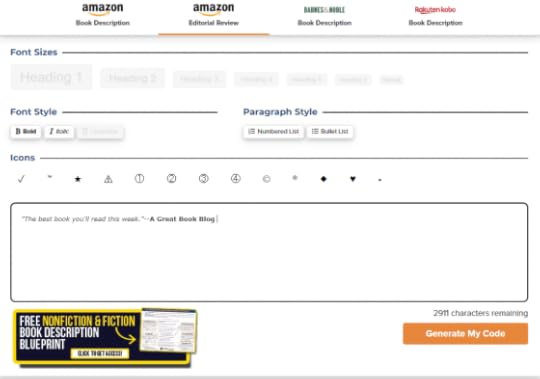
I simply navigate to the Editorial Review Generator, input my text, and play around with it until I have exactly what I want. After that, I simply hit Generate My Code.
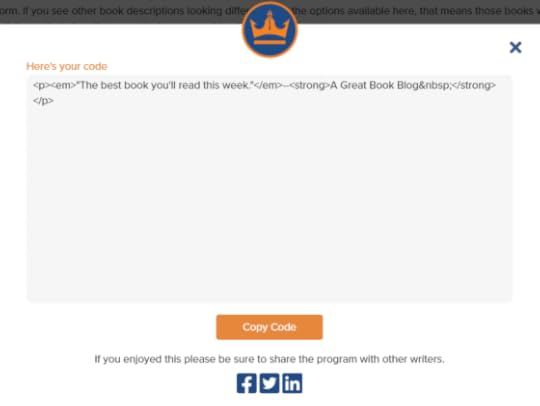
And there you have it. I can take this code and upload it directly to Author Central.
So, remember to source those editorial reviews, format them, and take advantage of this section that too many authors ignore.
Jane Friedman
- Jane Friedman's profile
- 1882 followers



